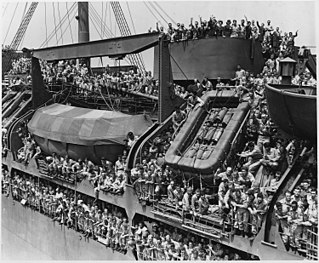
Scott Air Force Base is a United States Air Force base in St. Clair County, Illinois, near Belleville and O'Fallon, 17 miles (27 km) east-southeast of downtown St. Louis. Scott Field was one of 32 Air Service training camps established after the United States entered World War I in April 1917. It is headquarters of Air Mobility Command (AMC) and its showcase wing, and it is also the headquarters of the U.S. Transportation Command, a Unified Combatant Command that coordinates transportation across all the services.

The National Personnel Records Center fire of 1973, also known as the 1973 National Archives fire, was a fire that occurred at the Military Personnel Records Center (MPRC) in the St. Louis suburb of Overland, Missouri, from July 12–16, 1973.
The National Personnel Records Center(s) (NPRC) is an agency of the National Archives and Records Administration, created in 1966. It is part of the United States National Archives federal records center system and is divided into two large Federal Records Centers located in St. Louis, Missouri, and Valmeyer, Illinois. The term "National Personnel Records Center" is often used to describe both the physical Military Personnel Records Center facility and as a broader term for all records centers in the St. Louis area. To differentiate, the broader collection is occasionally called the "National Personnel Records Centers".

The 31st Infantry Division ("Dixie") was an infantry division of the United States Army National Guard, active almost continuously from 1917 to 1968. Composed of men from Alabama, Florida, Georgia, Louisiana, Michigan, Illinois, and Mississippi at various points in its existence, the division saw service in both World War I and World War II, and was mobilized during the Korean War, although it was not sent overseas in the latter.

United States Naval Reserve (Women's Reserve), better known as the WAVES (for Women Accepted for Volunteer Emergency Service), was the women's branch of the United States Naval Reserve during World War II. It was established on July 21, 1942, by the U.S. Congress and signed into law by President Franklin D. Roosevelt on July 30. This authorized the U.S. Navy to accept women into the Naval Reserve as commissioned officers and at the enlisted level, effective for the duration of the war plus six months. The purpose of the law was to release officers and men for sea duty and replace them with women in shore establishments. Mildred H. McAfee, on leave as president of Wellesley College, became the first director of the WAVES. She was commissioned a lieutenant commander on August 3, 1942, and later promoted to commander and then to captain.

The United States Army's Officer Candidate School (OCS) is an officer candidate school located at Fort Moore, Georgia, that trains, assesses, and evaluates potential commissioned officers of the U.S. Army, U.S. Army Reserve, and Army National Guard. Officer candidates are former enlisted members, warrant officers, inter-service transfers, or civilian college graduates who enlist for the "OCS Option" after they complete Basic Combat Training (BCT). The latter are often referred to as college ops.
The Military Personnel Records Center (NPRC-MPR) is a branch of the National Personnel Records Center and is the repository of over 56 million military personnel records and medical records pertaining to retired, discharged, and deceased veterans of the U.S. armed forces.

Carlisle Barracks is a United States Army facility located in Carlisle, Pennsylvania. The site of the U.S. Army War College, it is the nation's second-oldest active military base. The first structures were built in 1757, during the French and Indian War between Great Britain and France in the colonies.

The United States Army Ordnance Corps, formerly the United States Army Ordnance Department, is a sustainment branch of the United States Army, headquartered at Fort Lee, Virginia. The broad mission of the Ordnance Corps is to supply Army combat units with weapons and ammunition, including at times their procurement and maintenance. Along with the Quartermaster Corps and Transportation Corps, it forms a critical component of the U.S. Army logistics system.
A service record is a collection of either electronic or printed material which provides a documentary history of a person's activities and accomplishments while serving as a member of a given organization. Service records are most often associated with the military, but are commonly found in other groups, such as large corporations or for use by employees of a civilian government.

The Georgia Air National Guard is the aerial militia of the State of Georgia, United States of America. It is, along with the Georgia Army National Guard, an element of the Georgia National Guard.

The Army Service Forces was one of the three autonomous components of the United States Army during World War II, the others being the Army Air Forces and Army Ground Forces, created on 9 March 1942. By dividing the Army into three large commands, the Chief of Staff, General George C. Marshall, drastically reduced the number of officers and agencies reporting directly to him. The Army Service Forces brought together elements of five different components of the Army: elements of the War Department General Staff (WDGS), especially its G-4 division ; the Office of the Under Secretary of War; the eight administrative bureaus; the nine corps areas, which became service commands; and the six supply arms and services, which became known as the technical services. The Army Service Forces was initially known as the United States Army Services of Supply but the name was changed on 12 March 1943, as it was felt that the term "supply" did not accurately describe the broad range of its activities. The Army Service Forces was abolished on 11 June 1946 and most of its functions were taken over by the War Department General Staff.

The United States Army Transport Service (ATS) was established as a sea-going transport service that was independent of the Navy Department. ATS operated army transport ships for both troop transport and cargo service between United States ports and overseas posts. This service is often confused with the Army Transportation Service, created in France in 1917 to manage American Expeditionary Forces transport. ATS was a branch of the Quartermaster Corps responsible for land and water transport, becoming a separate United States Army Transportation Corps on July 31, 1942.

The 115th Airlift Squadron is a unit of the California Air National Guard 146th Airlift Wing located at Channel Islands Air National Guard Station, Oxnard, California. The 115th is equipped with the C-130J Hercules.
Service numbers were used by the United States Army from 1918 until 1969. Prior to this time, the Army relied on muster rolls as a means of indexing enlisted service members while officers were usually listed on yearly rolls maintained by the United States War Department. In the nineteenth century, the Army also used pay records as a primary means of identifying service members after discharge.

Naval Support Activity Mid-South, in Millington, Tennessee, is a base of the United States Navy. A part of the Navy Region Southeast and the Navy Installations Command, NSA Mid-South serves as the Navy’s Human Resources Center of Excellence. The base is host to several commands and other military tenants: Navy Personnel Command, Navy Recruiting Command, the Navy Manpower Analysis Center, a Marine reserve Company - Bridge Company C and the US Army Corps of Engineers Finance Center. More than 7,500 military, civilian, and contract personnel are assigned/work on base.

The Demobilization of United States armed forces after the Second World War began with the defeat of Germany in May 1945 and continued through 1946. The United States had more than 12 million men and women in the armed forces at the end of World War II, of whom 7.6 million were stationed abroad. The American public demanded a rapid demobilization and soldiers protested the slowness of the process. Military personnel were returned to the United States in Operation Magic Carpet. By June 30, 1947, the number of active duty soldiers, sailors, Marines, and airmen in the armed forces had been reduced to 1,566,000.

The Chatham Artillery is an artillery unit that has played a leading role in the history of the state of Georgia since the American Revolution. In 1776, Thomas Lee was authorized to enlist a provincial company of artillery for the defense of Savannah, the first such unit in Georgia's history. Commanded by Joseph Woodruff, they defended the right flank of American forces when the British attacked Savannah. They saw service in the Oconnee wars, The Embargo Wars, and The War of 1812. They were part of the force that occupied Fort Pulaski that opened the American Civil War, and served in and around Savannah and Charleston South Carolina before joining General Johnston's forces in Columbia, South Carolina. After the reorganization in 1872, they mustered out to the border with Mexico, to stop Pancho Villa's raids in the United States. They served with the "Dixie Division" in France during World War I, and landed on Normandy Beach on D-day plus 4 in World War II. They breached the Siegfried Line, and were at the Elbe River when the war ended. In 2005 they were mobilized again into federal service, as an element of the 48th Brigade Combat team serving in Iraq, part of Operation Iraqi Freedom. The Chatham Artillery was re-mobilized in 2009 to support Operation Enduring Freedom in Afghanistan, personally training Afghan Troops and Police Forces. They were demobilized in 2010 at Fort Stewart, Georgia. Today they remain in service, as a modular artillery brigade of the Georgia Army National Guard, the 118th Field Artillery.

The National Archives at College Park is a major facility of the National Archives and Records Administration of the United States which is located in College Park, Maryland. The facility serves as the primary base of operations for the bulk of the senior offices within the organization of the National Archives. The facility operates in tandem with the National Archives Building in Washington, D.C. which serves as the ceremonial headquarters of the National Archives in that this is where the Archivist of the United States maintains their primary office.















